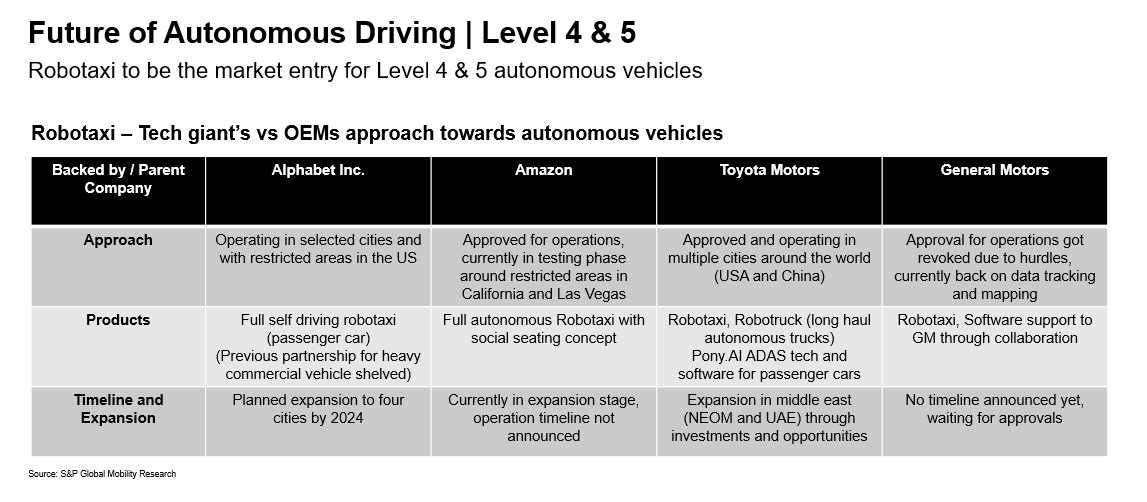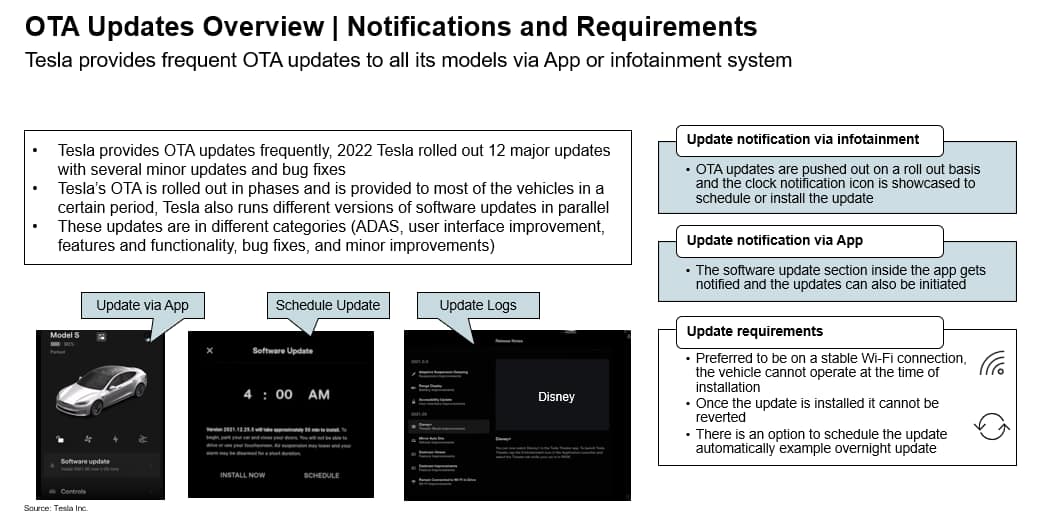Discover more about S&P Global's offerings
Customer Logins
Obtain the data you need to make the most informed decisions by accessing our extensive portfolio of information, analytics, and expertise. Sign in to the product or service center of your choice.
Customer Logins
BLOG
Jun 24, 2024
OTA updates and Software Defined Vehicles empower self driving cars
Advanced driver assistance systems (ADAS) continue to develop.
Software defined vehicles herald a new age of mobility. Advancements in connected vehicle technology and over the air updates drive this shift, with Level 3 automation another milestone toward fully autonomous vehicles.
Software defined vehicles(SDVs) are revolutionizing the driving experience. The trifecta of autonomous driving with capabilities and over the air updates enhances vehicles' operability and functionality. How can OEMs and suppliers capitalize? More importantly, what role will they play in autonomous driving?
The Evolution of Autonomous Driving
Automotive manufacturers have offered relatively simple Level 2 systems for more than a decade, but it was the advent of Level 2+ that really moved the industry from Advanced Drive Assistance Systems (ADAS) to Automated Driving. By integrating advanced sensors and vehicle software into a more holistic system design, L2+ vehicles from Tesla to Cadillac could achieve new functionality combining steering and acceleration and more—but this partial automation still requires the driver to remain engaged. Today, BMW, Mercedes, and more are joined by a host of tech-forward Chinese brands from NIO to Huawei that are actively developing Level 3 autonomous vehicles to manage more complex driving scenarios and to relieve the driver of constant supervision.

While the vast majority of the industry is focused on L2+ and some on L3, Levels 4 and 5 automation, i.e., fully self driving cars, remain a long-term industry goal and a near-term focus for a select few. If fully developed and safely implemented, the technology's potential is tantalizing. Tech giants like Alphabet's Google and Amazon are backing innovative startups such as Waymo and Zoox to push the boundaries of Level 4 autonomy. At this level, vehicles are fully autonomous and operate independently in geofenced areas. They integrate advanced software—evolving from machine learning algorithms to full stack training using Large Visual Models—with the latest sensor technologies to navigate without human input. The industry envisions a future where cars are not just vehicles but sophisticated mobility solutions—for instance, driverless car technology such as robo-taxis navigating city streets and transporting passengers without human intervention
The Impact of Advanced Driver Assistance Systems (ADAS)
Across the industry, Advanced Driver Assistance Systems (ADAS) are rapidly developing in both safety and driving efficiency. System capabilities like hands-free driving cars with the support of Driver Facial Monitoring systems are increasingly sophisticated. Tesla, a leader in this field, has improved its software to handle dense urban driving and intersections as well as more traditional highway cruising functions that are the early focus of other.

The Role of Over the Air Updates in Modern Vehicles
Another transformative aspect of software defined vehicles is the ability to improve and upgrade continuously through remote over the air updates. Automotive manufacturers can update software, fix bugs, enhance functionalities, and even add new features without requiring physical modifications to the vehicle. Tesla delivers frequent updates in select groups of vehicles in phases through the infotainment or app. This approach has caught on with other automotive manufacturers like Rivian, which adopt similar strategies.
The new age EV automotive manufacturers focus on vertical integration and advanced technology that gives them the advantage of systems compatibility. Integrating over the air updates comes with challenges. Managing software across various hardware components, often from different suppliers, requires a sophisticated coordination and testing process to ensure compatibility and performance. Despite this, the benefits of over the air updates are immense. It eases the burden of recalls and enables automotive manufacturers to swiftly respond to user feedback and emerging technologies, while also opening up a new revenue stream.
Importance of Software Architecture in Software Defined Vehicles
As vehicles become more software-centric, the connected vehicle technologyis increasingly critical. Connected vehicle technology refers to integrating advanced communication and information systems within vehicles. They enhance vehicle functionality by providing safety features, entertainment options, and real-time diagnostics. The industry's push towards using telematics and vehicle-to-everything (V2X) communication enables vehicles to interact with the city infrastructure and other vehicles to enhance road safety and traffic management.
Efficiencies in software architecture are necessary to support modern cars' growing interconnectivity and advanced functionalities. Developing this standardized architecture is a crucial priority for automotive manufacturers and suppliers. Investments and strategic partnerships from chipmaker Qualcomm and software giant Microsoft, will improve on connected vehicle technology by defining digital cockpit, providing advanced systems enabled by gen AI and equipped with latest sets of connect features and advanced driver assistance systems for the industry.
Challenges in Global Autonomous Vehicles Adoption
Despite theseadvanced driver assistance systems, there are obstacles to widespread adoption of autonomous vehicles. Legislation and infrastructure vary significantly across different regions, creating a patchwork of regulations that automotive manufacturers must navigate carefully. Deployment of Level 3 and Level 4 vehicles will be extremely localized so the fragmented regulatory landscape and harmonization across global markets is a challenge but it's not a non-starter. Vehicle-based perception and planning is also being developed to be infrastructure-agnostic, but connectivity and network coverage do represent more headwinds, especially as automotive manufacturers seek to achieve global scale and simpler supply chains.
The shift towards software defined vehicles is one enabler of growing vehicle autonomy and increased connectivity. OEM, supplier, and industry innovations will redefine our relationship with cars, making them more adaptable, safer, and more attuned to the needs of their users.
This article is part of a series featuring highlights from S&P Global Mobility's 2024 Solutions Webinar Series. Unveiling the Latest Trends in Autonomous Driving, Connectivity and Over The Air Updates webinar occurred on April 25, 2024.
Register for additional webinar sessions.
This article was published by S&P Global Mobility and not by S&P Global Ratings, which is a separately managed division of S&P Global.
{"items" : [
{"name":"share","enabled":true,"desc":"<strong>Share</strong>","mobdesc":"Share","options":[ {"name":"facebook","url":"https://www.facebook.com/sharer.php?u=http%3a%2f%2fstage.www.spglobal.com%2fmobility%2fen%2fresearch-analysis%2fconnectivity-and-ota-updates.html","enabled":true},{"name":"twitter","url":"https://twitter.com/intent/tweet?url=http%3a%2f%2fstage.www.spglobal.com%2fmobility%2fen%2fresearch-analysis%2fconnectivity-and-ota-updates.html&text=OTA+updates+and+Software+Defined+Vehicles+empower+self+driving+cars+%7c+S%26P+Global+","enabled":true},{"name":"linkedin","url":"https://www.linkedin.com/sharing/share-offsite/?url=http%3a%2f%2fstage.www.spglobal.com%2fmobility%2fen%2fresearch-analysis%2fconnectivity-and-ota-updates.html","enabled":true},{"name":"email","url":"?subject=OTA updates and Software Defined Vehicles empower self driving cars | S&P Global &body=http%3a%2f%2fstage.www.spglobal.com%2fmobility%2fen%2fresearch-analysis%2fconnectivity-and-ota-updates.html","enabled":true},{"name":"whatsapp","url":"https://api.whatsapp.com/send?text=OTA+updates+and+Software+Defined+Vehicles+empower+self+driving+cars+%7c+S%26P+Global+ http%3a%2f%2fstage.www.spglobal.com%2fmobility%2fen%2fresearch-analysis%2fconnectivity-and-ota-updates.html","enabled":true}]}, {"name":"rtt","enabled":true,"mobdesc":"Top"}
]}


